University Corporate Accounting: Fair Value Accounting Report
VerifiedAdded on 2022/09/16
|10
|2064
|18
Report
AI Summary
This report provides a comprehensive analysis of fair value accounting. Part A discusses the importance of fair value accounting in the modern business world, its advantages, and different approaches, including market, income, and cost approaches. It emphasizes how fair value accounting helps companies manage assets and liabilities, maintain stakeholder interests, and mitigate financial statement misrepresentation. Part B presents a case study of Virgin Holdings Ltd's 2019 annual report, demonstrating the company's use of fair value accounting in various transactions, such as valuing assets, liabilities, and acquisitions. The report highlights how Virgin Holdings Ltd. adheres to the fair value hierarchy and concludes that the company effectively utilizes fair value accounting methods in its financial reporting. The report is based on the ACC202 Corporate Accounting module and follows Harvard referencing style with current and relevant sources.
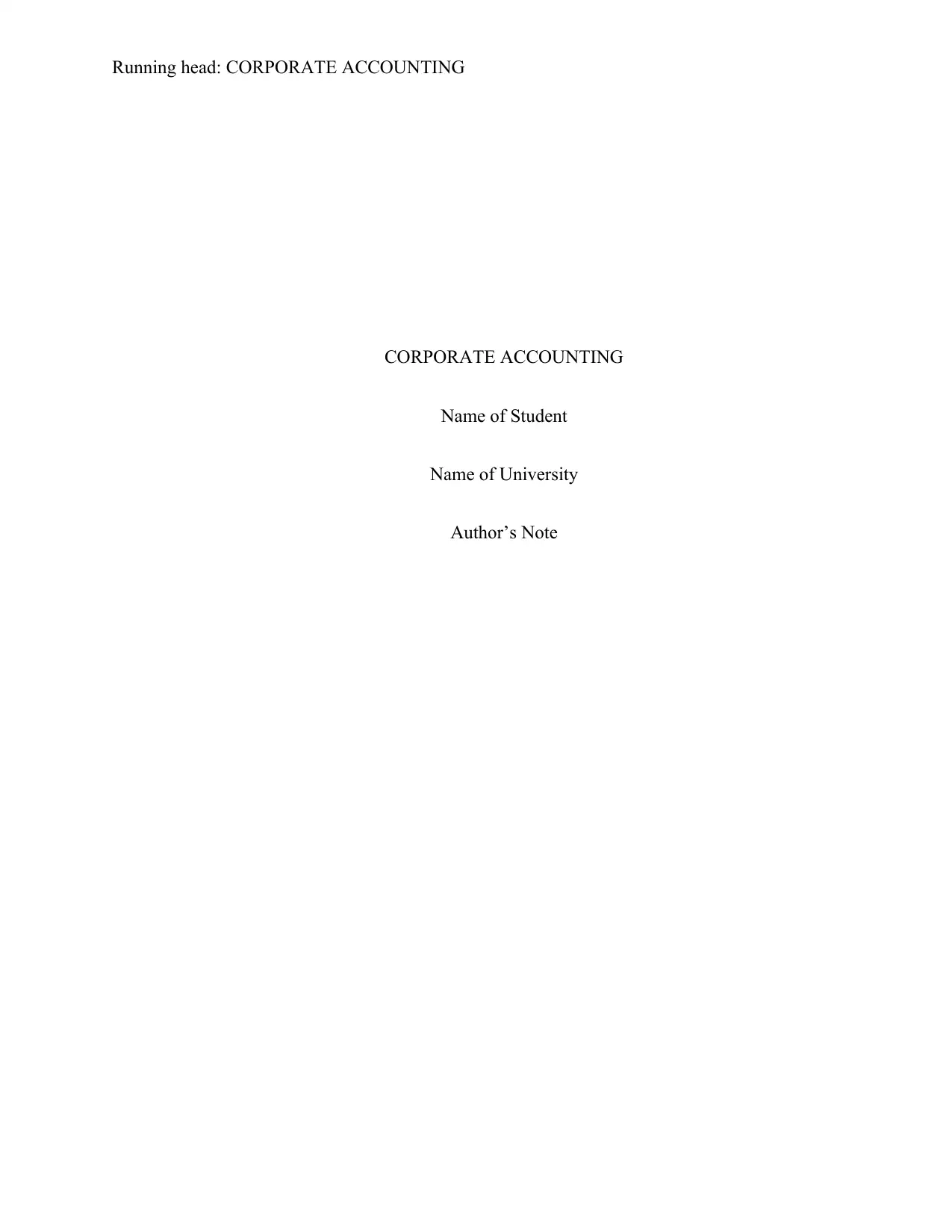
Running head: CORPORATE ACCOUNTING
CORPORATE ACCOUNTING
Name of Student
Name of University
Author’s Note
CORPORATE ACCOUNTING
Name of Student
Name of University
Author’s Note
Paraphrase This Document
Need a fresh take? Get an instant paraphrase of this document with our AI Paraphraser
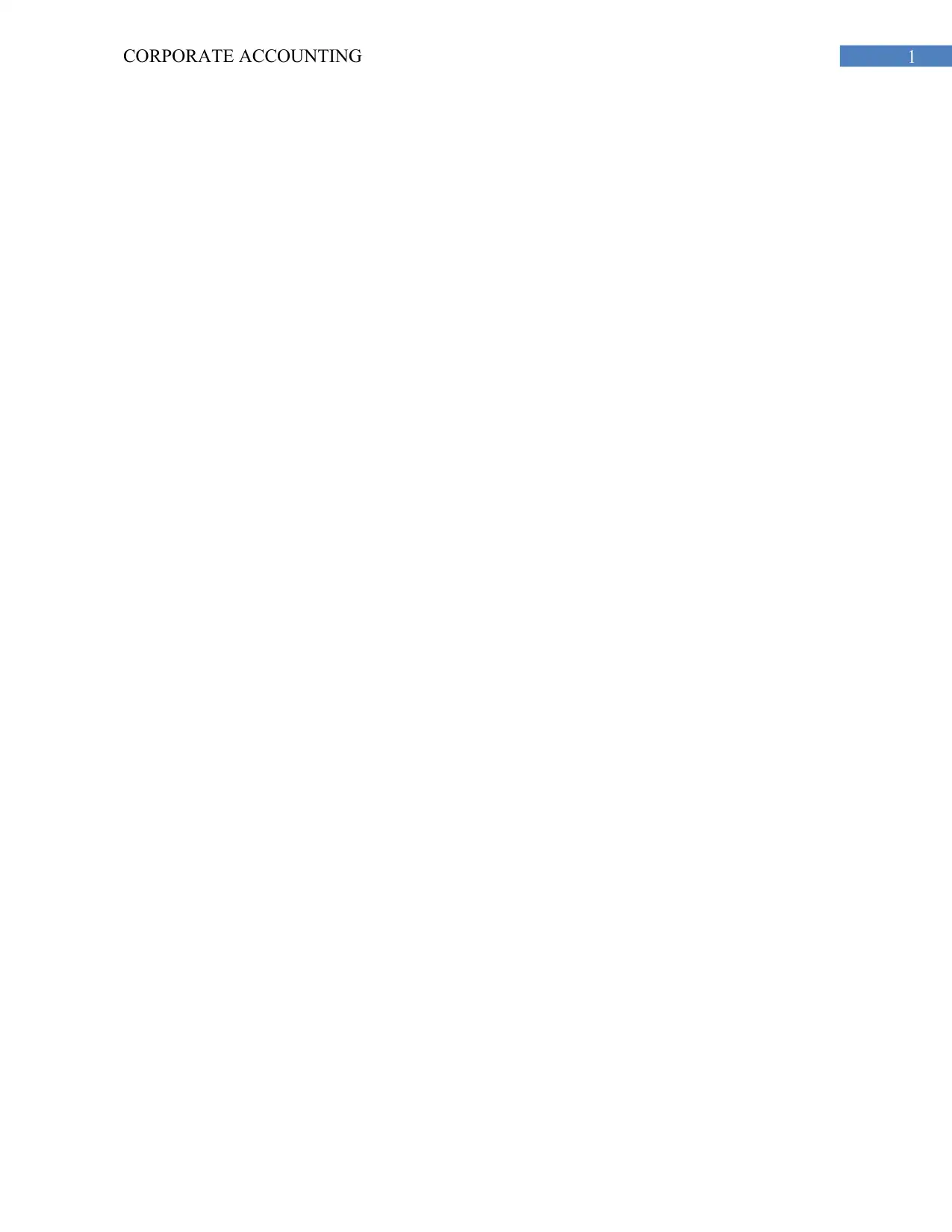
1CORPORATE ACCOUNTING
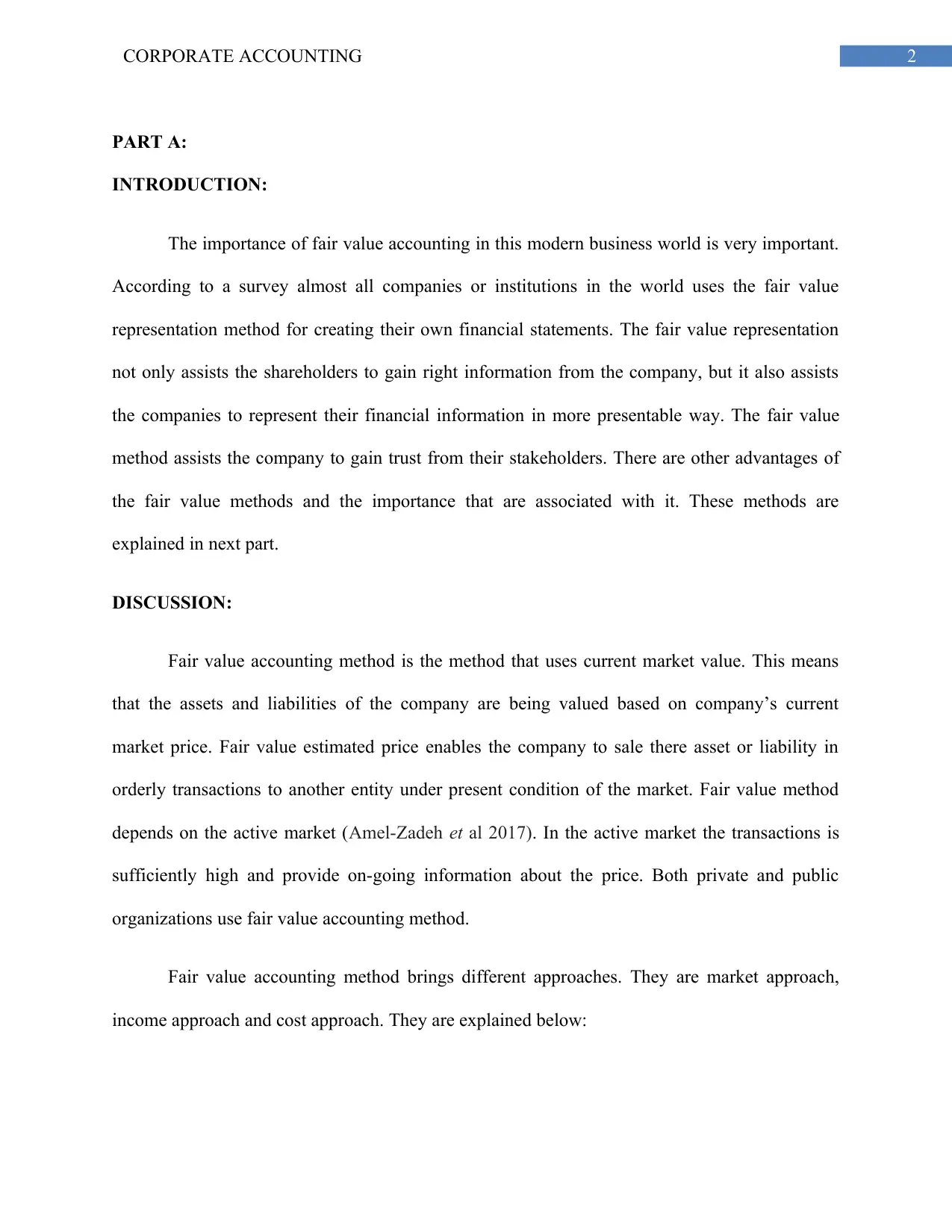
2CORPORATE ACCOUNTING
PART A:
INTRODUCTION:
The importance of fair value accounting in this modern business world is very important.
According to a survey almost all companies or institutions in the world uses the fair value
representation method for creating their own financial statements. The fair value representation
not only assists the shareholders to gain right information from the company, but it also assists
the companies to represent their financial information in more presentable way. The fair value
method assists the company to gain trust from their stakeholders. There are other advantages of
the fair value methods and the importance that are associated with it. These methods are
explained in next part.
DISCUSSION:
Fair value accounting method is the method that uses current market value. This means
that the assets and liabilities of the company are being valued based on company’s current
market price. Fair value estimated price enables the company to sale there asset or liability in
orderly transactions to another entity under present condition of the market. Fair value method
depends on the active market (Amel-Zadeh et al 2017). In the active market the transactions is
sufficiently high and provide on-going information about the price. Both private and public
organizations use fair value accounting method.
Fair value accounting method brings different approaches. They are market approach,
income approach and cost approach. They are explained below:
PART A:
INTRODUCTION:
The importance of fair value accounting in this modern business world is very important.
According to a survey almost all companies or institutions in the world uses the fair value
representation method for creating their own financial statements. The fair value representation
not only assists the shareholders to gain right information from the company, but it also assists
the companies to represent their financial information in more presentable way. The fair value
method assists the company to gain trust from their stakeholders. There are other advantages of
the fair value methods and the importance that are associated with it. These methods are
explained in next part.
DISCUSSION:
Fair value accounting method is the method that uses current market value. This means
that the assets and liabilities of the company are being valued based on company’s current
market price. Fair value estimated price enables the company to sale there asset or liability in
orderly transactions to another entity under present condition of the market. Fair value method
depends on the active market (Amel-Zadeh et al 2017). In the active market the transactions is
sufficiently high and provide on-going information about the price. Both private and public
organizations use fair value accounting method.
Fair value accounting method brings different approaches. They are market approach,
income approach and cost approach. They are explained below:
⊘ This is a preview!⊘
Do you want full access?
Subscribe today to unlock all pages.

Trusted by 1+ million students worldwide
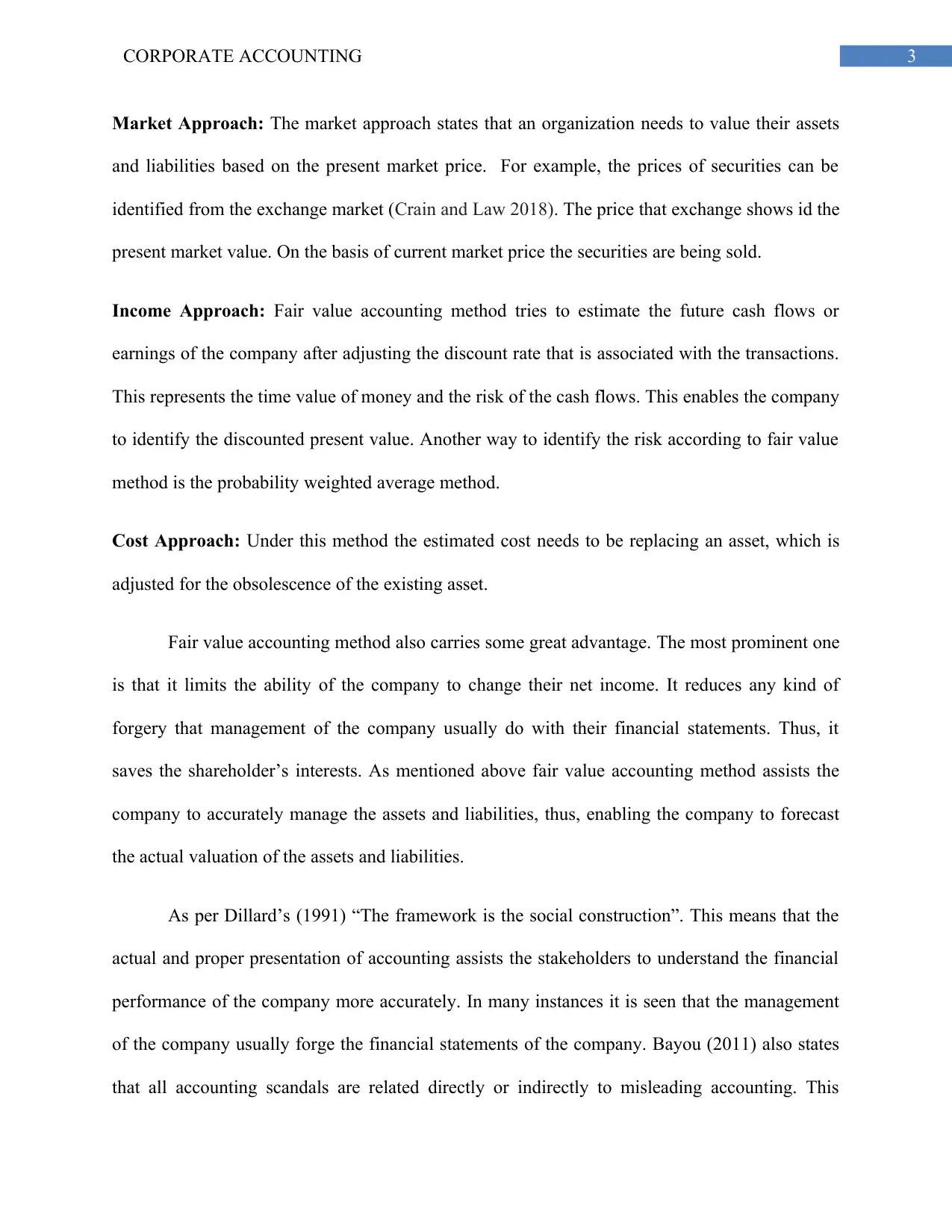
3CORPORATE ACCOUNTING
Market Approach: The market approach states that an organization needs to value their assets
and liabilities based on the present market price. For example, the prices of securities can be
identified from the exchange market (Crain and Law 2018). The price that exchange shows id the
present market value. On the basis of current market price the securities are being sold.
Income Approach: Fair value accounting method tries to estimate the future cash flows or
earnings of the company after adjusting the discount rate that is associated with the transactions.
This represents the time value of money and the risk of the cash flows. This enables the company
to identify the discounted present value. Another way to identify the risk according to fair value
method is the probability weighted average method.
Cost Approach: Under this method the estimated cost needs to be replacing an asset, which is
adjusted for the obsolescence of the existing asset.
Fair value accounting method also carries some great advantage. The most prominent one
is that it limits the ability of the company to change their net income. It reduces any kind of
forgery that management of the company usually do with their financial statements. Thus, it
saves the shareholder’s interests. As mentioned above fair value accounting method assists the
company to accurately manage the assets and liabilities, thus, enabling the company to forecast
the actual valuation of the assets and liabilities.
As per Dillard’s (1991) “The framework is the social construction”. This means that the
actual and proper presentation of accounting assists the stakeholders to understand the financial
performance of the company more accurately. In many instances it is seen that the management
of the company usually forge the financial statements of the company. Bayou (2011) also states
that all accounting scandals are related directly or indirectly to misleading accounting. This
Market Approach: The market approach states that an organization needs to value their assets
and liabilities based on the present market price. For example, the prices of securities can be
identified from the exchange market (Crain and Law 2018). The price that exchange shows id the
present market value. On the basis of current market price the securities are being sold.
Income Approach: Fair value accounting method tries to estimate the future cash flows or
earnings of the company after adjusting the discount rate that is associated with the transactions.
This represents the time value of money and the risk of the cash flows. This enables the company
to identify the discounted present value. Another way to identify the risk according to fair value
method is the probability weighted average method.
Cost Approach: Under this method the estimated cost needs to be replacing an asset, which is
adjusted for the obsolescence of the existing asset.
Fair value accounting method also carries some great advantage. The most prominent one
is that it limits the ability of the company to change their net income. It reduces any kind of
forgery that management of the company usually do with their financial statements. Thus, it
saves the shareholder’s interests. As mentioned above fair value accounting method assists the
company to accurately manage the assets and liabilities, thus, enabling the company to forecast
the actual valuation of the assets and liabilities.
As per Dillard’s (1991) “The framework is the social construction”. This means that the
actual and proper presentation of accounting assists the stakeholders to understand the financial
performance of the company more accurately. In many instances it is seen that the management
of the company usually forge the financial statements of the company. Bayou (2011) also states
that all accounting scandals are related directly or indirectly to misleading accounting. This
Paraphrase This Document
Need a fresh take? Get an instant paraphrase of this document with our AI Paraphraser
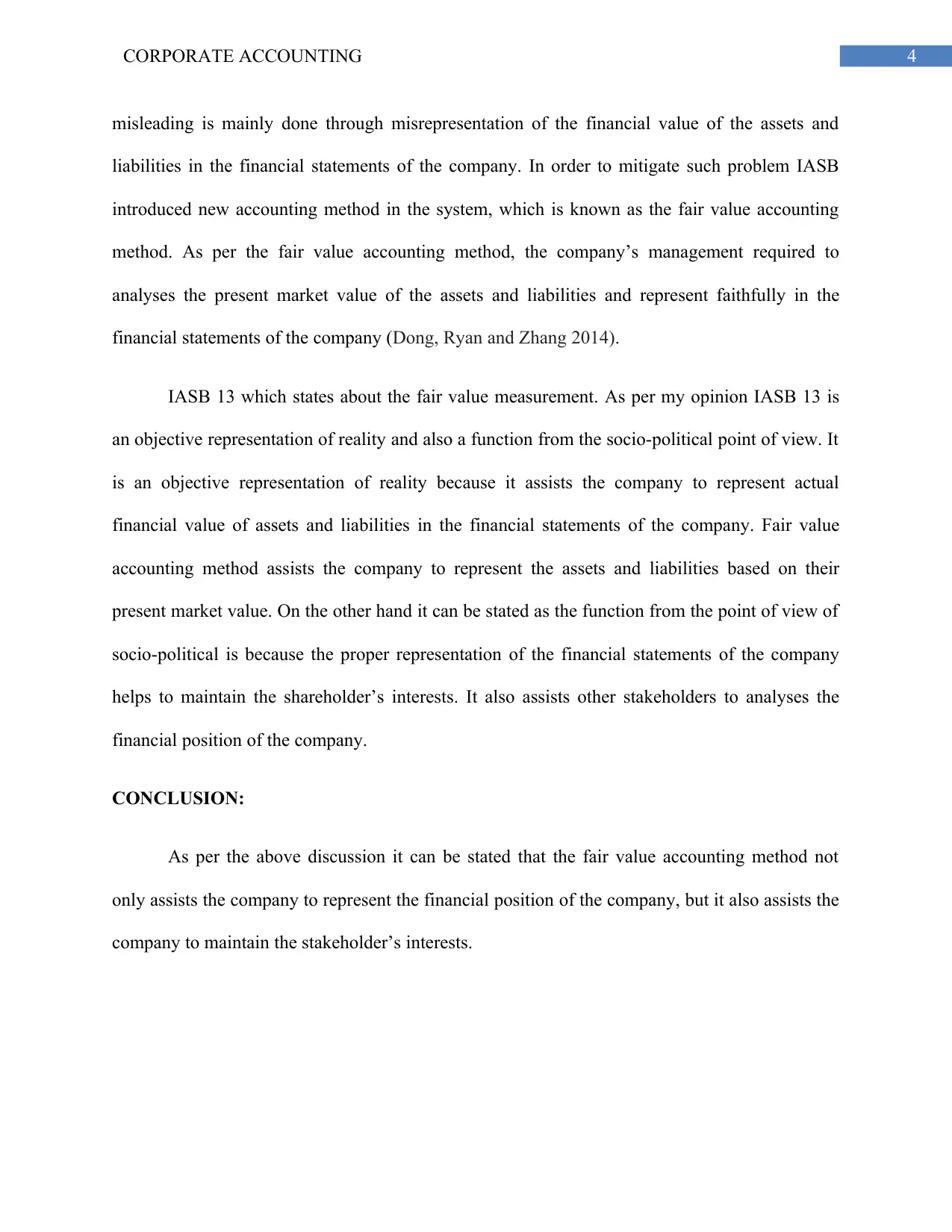
4CORPORATE ACCOUNTING
misleading is mainly done through misrepresentation of the financial value of the assets and
liabilities in the financial statements of the company. In order to mitigate such problem IASB
introduced new accounting method in the system, which is known as the fair value accounting
method. As per the fair value accounting method, the company’s management required to
analyses the present market value of the assets and liabilities and represent faithfully in the
financial statements of the company (Dong, Ryan and Zhang 2014).
IASB 13 which states about the fair value measurement. As per my opinion IASB 13 is
an objective representation of reality and also a function from the socio-political point of view. It
is an objective representation of reality because it assists the company to represent actual
financial value of assets and liabilities in the financial statements of the company. Fair value
accounting method assists the company to represent the assets and liabilities based on their
present market value. On the other hand it can be stated as the function from the point of view of
socio-political is because the proper representation of the financial statements of the company
helps to maintain the shareholder’s interests. It also assists other stakeholders to analyses the
financial position of the company.
CONCLUSION:
As per the above discussion it can be stated that the fair value accounting method not
only assists the company to represent the financial position of the company, but it also assists the
company to maintain the stakeholder’s interests.
misleading is mainly done through misrepresentation of the financial value of the assets and
liabilities in the financial statements of the company. In order to mitigate such problem IASB
introduced new accounting method in the system, which is known as the fair value accounting
method. As per the fair value accounting method, the company’s management required to
analyses the present market value of the assets and liabilities and represent faithfully in the
financial statements of the company (Dong, Ryan and Zhang 2014).
IASB 13 which states about the fair value measurement. As per my opinion IASB 13 is
an objective representation of reality and also a function from the socio-political point of view. It
is an objective representation of reality because it assists the company to represent actual
financial value of assets and liabilities in the financial statements of the company. Fair value
accounting method assists the company to represent the assets and liabilities based on their
present market value. On the other hand it can be stated as the function from the point of view of
socio-political is because the proper representation of the financial statements of the company
helps to maintain the shareholder’s interests. It also assists other stakeholders to analyses the
financial position of the company.
CONCLUSION:
As per the above discussion it can be stated that the fair value accounting method not
only assists the company to represent the financial position of the company, but it also assists the
company to maintain the stakeholder’s interests.
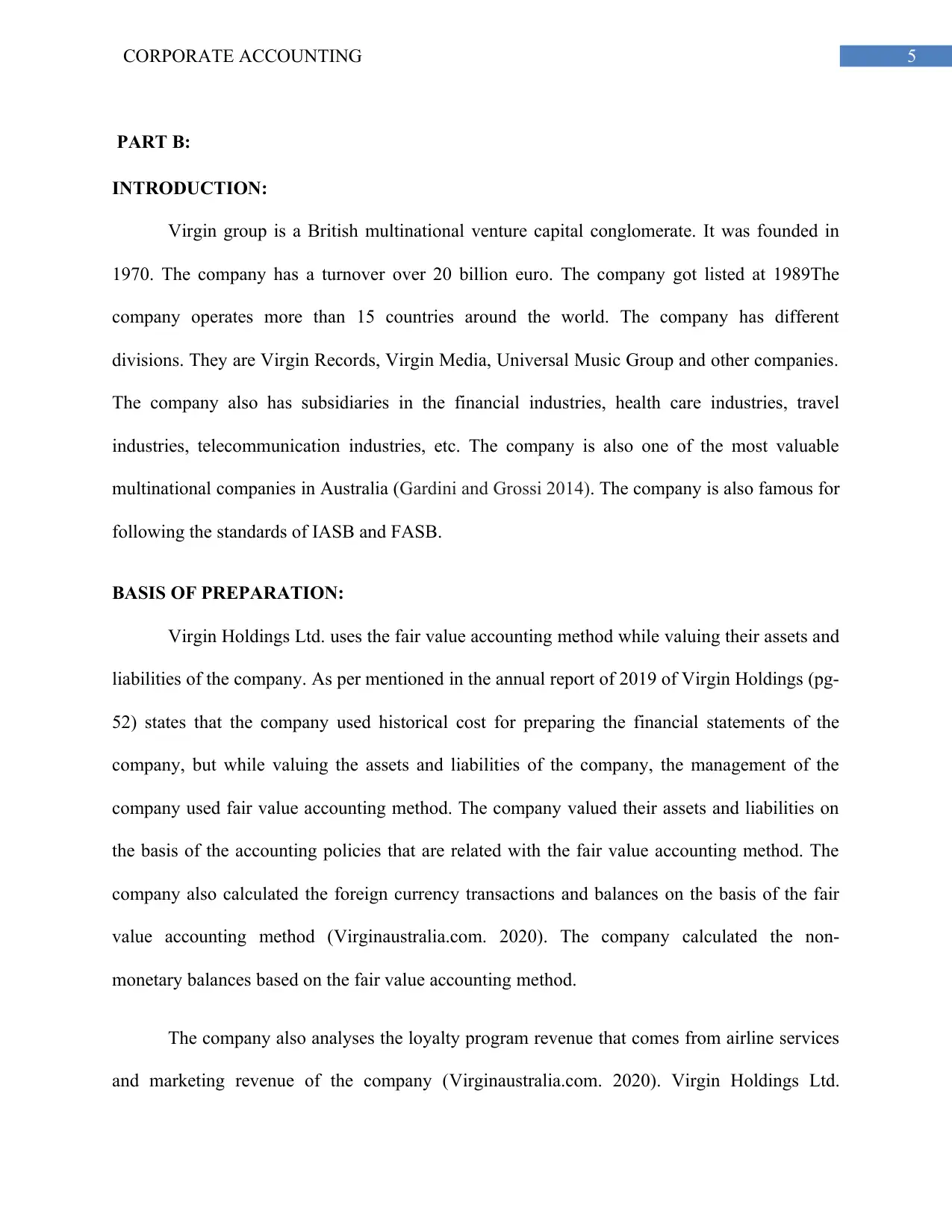
5CORPORATE ACCOUNTING
PART B:
INTRODUCTION:
Virgin group is a British multinational venture capital conglomerate. It was founded in
1970. The company has a turnover over 20 billion euro. The company got listed at 1989The
company operates more than 15 countries around the world. The company has different
divisions. They are Virgin Records, Virgin Media, Universal Music Group and other companies.
The company also has subsidiaries in the financial industries, health care industries, travel
industries, telecommunication industries, etc. The company is also one of the most valuable
multinational companies in Australia (Gardini and Grossi 2014). The company is also famous for
following the standards of IASB and FASB.
BASIS OF PREPARATION:
Virgin Holdings Ltd. uses the fair value accounting method while valuing their assets and
liabilities of the company. As per mentioned in the annual report of 2019 of Virgin Holdings (pg-
52) states that the company used historical cost for preparing the financial statements of the
company, but while valuing the assets and liabilities of the company, the management of the
company used fair value accounting method. The company valued their assets and liabilities on
the basis of the accounting policies that are related with the fair value accounting method. The
company also calculated the foreign currency transactions and balances on the basis of the fair
value accounting method (Virginaustralia.com. 2020). The company calculated the non-
monetary balances based on the fair value accounting method.
The company also analyses the loyalty program revenue that comes from airline services
and marketing revenue of the company (Virginaustralia.com. 2020). Virgin Holdings Ltd.
PART B:
INTRODUCTION:
Virgin group is a British multinational venture capital conglomerate. It was founded in
1970. The company has a turnover over 20 billion euro. The company got listed at 1989The
company operates more than 15 countries around the world. The company has different
divisions. They are Virgin Records, Virgin Media, Universal Music Group and other companies.
The company also has subsidiaries in the financial industries, health care industries, travel
industries, telecommunication industries, etc. The company is also one of the most valuable
multinational companies in Australia (Gardini and Grossi 2014). The company is also famous for
following the standards of IASB and FASB.
BASIS OF PREPARATION:
Virgin Holdings Ltd. uses the fair value accounting method while valuing their assets and
liabilities of the company. As per mentioned in the annual report of 2019 of Virgin Holdings (pg-
52) states that the company used historical cost for preparing the financial statements of the
company, but while valuing the assets and liabilities of the company, the management of the
company used fair value accounting method. The company valued their assets and liabilities on
the basis of the accounting policies that are related with the fair value accounting method. The
company also calculated the foreign currency transactions and balances on the basis of the fair
value accounting method (Virginaustralia.com. 2020). The company calculated the non-
monetary balances based on the fair value accounting method.
The company also analyses the loyalty program revenue that comes from airline services
and marketing revenue of the company (Virginaustralia.com. 2020). Virgin Holdings Ltd.
⊘ This is a preview!⊘
Do you want full access?
Subscribe today to unlock all pages.

Trusted by 1+ million students worldwide
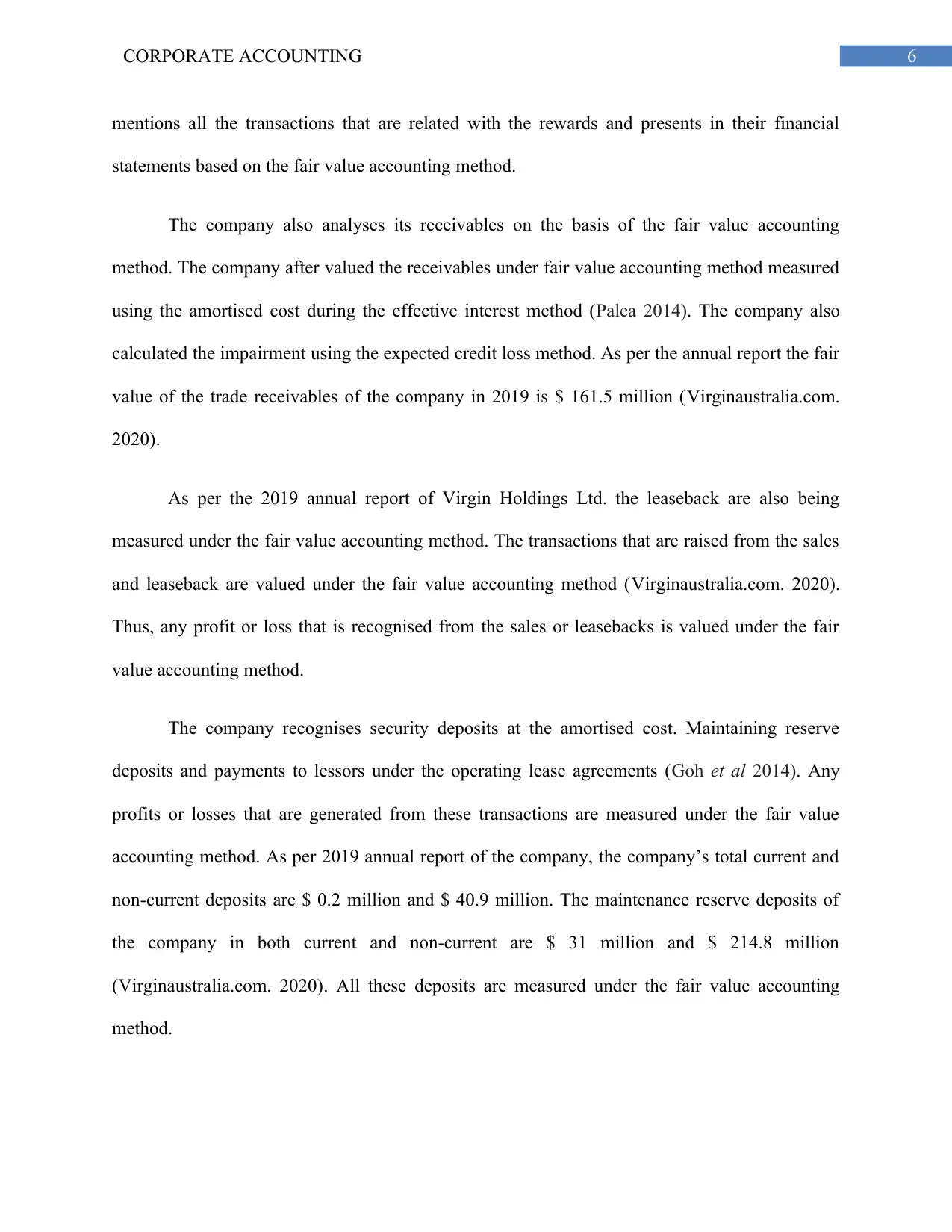
6CORPORATE ACCOUNTING
mentions all the transactions that are related with the rewards and presents in their financial
statements based on the fair value accounting method.
The company also analyses its receivables on the basis of the fair value accounting
method. The company after valued the receivables under fair value accounting method measured
using the amortised cost during the effective interest method (Palea 2014). The company also
calculated the impairment using the expected credit loss method. As per the annual report the fair
value of the trade receivables of the company in 2019 is $ 161.5 million (Virginaustralia.com.
2020).
As per the 2019 annual report of Virgin Holdings Ltd. the leaseback are also being
measured under the fair value accounting method. The transactions that are raised from the sales
and leaseback are valued under the fair value accounting method (Virginaustralia.com. 2020).
Thus, any profit or loss that is recognised from the sales or leasebacks is valued under the fair
value accounting method.
The company recognises security deposits at the amortised cost. Maintaining reserve
deposits and payments to lessors under the operating lease agreements (Goh et al 2014). Any
profits or losses that are generated from these transactions are measured under the fair value
accounting method. As per 2019 annual report of the company, the company’s total current and
non-current deposits are $ 0.2 million and $ 40.9 million. The maintenance reserve deposits of
the company in both current and non-current are $ 31 million and $ 214.8 million
(Virginaustralia.com. 2020). All these deposits are measured under the fair value accounting
method.
mentions all the transactions that are related with the rewards and presents in their financial
statements based on the fair value accounting method.
The company also analyses its receivables on the basis of the fair value accounting
method. The company after valued the receivables under fair value accounting method measured
using the amortised cost during the effective interest method (Palea 2014). The company also
calculated the impairment using the expected credit loss method. As per the annual report the fair
value of the trade receivables of the company in 2019 is $ 161.5 million (Virginaustralia.com.
2020).
As per the 2019 annual report of Virgin Holdings Ltd. the leaseback are also being
measured under the fair value accounting method. The transactions that are raised from the sales
and leaseback are valued under the fair value accounting method (Virginaustralia.com. 2020).
Thus, any profit or loss that is recognised from the sales or leasebacks is valued under the fair
value accounting method.
The company recognises security deposits at the amortised cost. Maintaining reserve
deposits and payments to lessors under the operating lease agreements (Goh et al 2014). Any
profits or losses that are generated from these transactions are measured under the fair value
accounting method. As per 2019 annual report of the company, the company’s total current and
non-current deposits are $ 0.2 million and $ 40.9 million. The maintenance reserve deposits of
the company in both current and non-current are $ 31 million and $ 214.8 million
(Virginaustralia.com. 2020). All these deposits are measured under the fair value accounting
method.
Paraphrase This Document
Need a fresh take? Get an instant paraphrase of this document with our AI Paraphraser
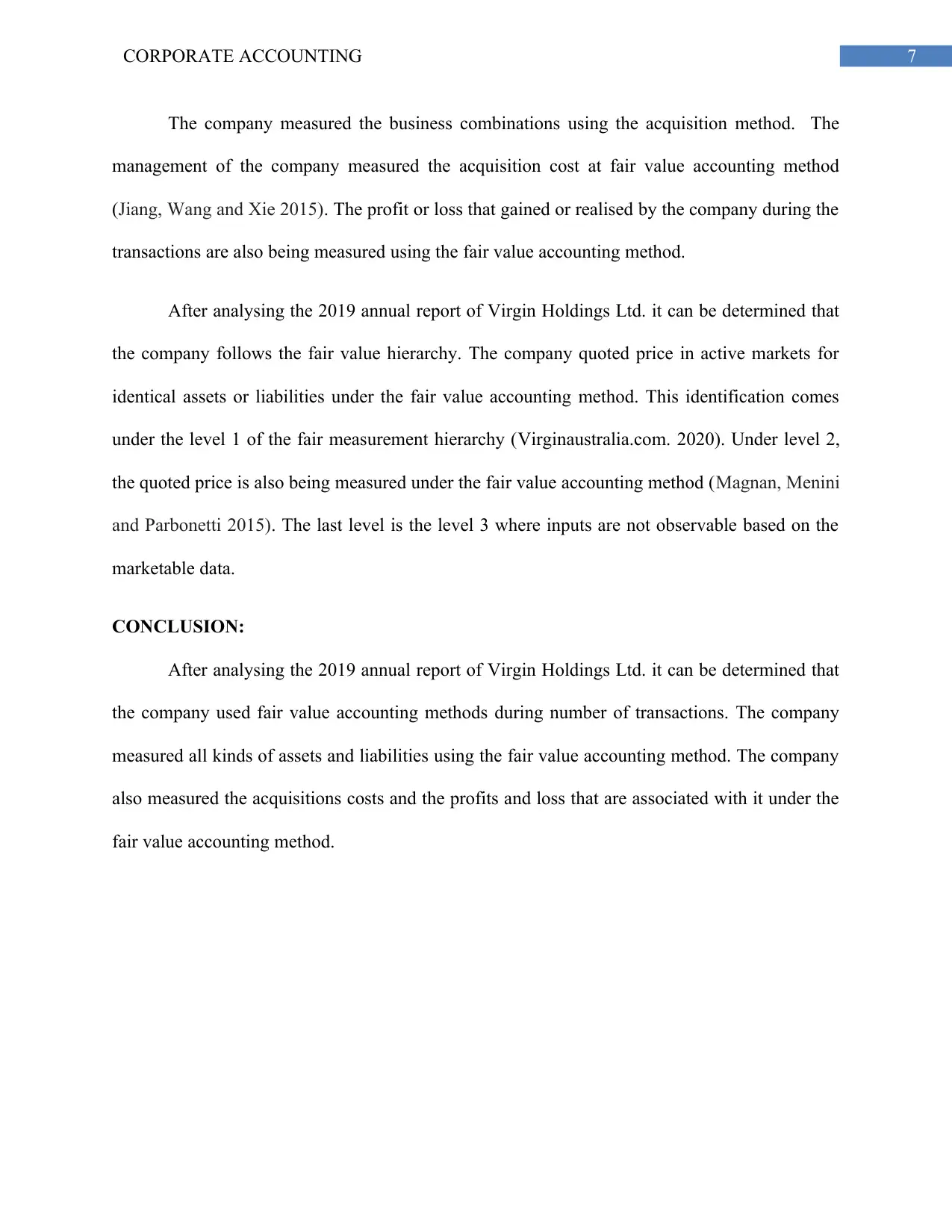
7CORPORATE ACCOUNTING
The company measured the business combinations using the acquisition method. The
management of the company measured the acquisition cost at fair value accounting method
(Jiang, Wang and Xie 2015). The profit or loss that gained or realised by the company during the
transactions are also being measured using the fair value accounting method.
After analysing the 2019 annual report of Virgin Holdings Ltd. it can be determined that
the company follows the fair value hierarchy. The company quoted price in active markets for
identical assets or liabilities under the fair value accounting method. This identification comes
under the level 1 of the fair measurement hierarchy (Virginaustralia.com. 2020). Under level 2,
the quoted price is also being measured under the fair value accounting method (Magnan, Menini
and Parbonetti 2015). The last level is the level 3 where inputs are not observable based on the
marketable data.
CONCLUSION:
After analysing the 2019 annual report of Virgin Holdings Ltd. it can be determined that
the company used fair value accounting methods during number of transactions. The company
measured all kinds of assets and liabilities using the fair value accounting method. The company
also measured the acquisitions costs and the profits and loss that are associated with it under the
fair value accounting method.
The company measured the business combinations using the acquisition method. The
management of the company measured the acquisition cost at fair value accounting method
(Jiang, Wang and Xie 2015). The profit or loss that gained or realised by the company during the
transactions are also being measured using the fair value accounting method.
After analysing the 2019 annual report of Virgin Holdings Ltd. it can be determined that
the company follows the fair value hierarchy. The company quoted price in active markets for
identical assets or liabilities under the fair value accounting method. This identification comes
under the level 1 of the fair measurement hierarchy (Virginaustralia.com. 2020). Under level 2,
the quoted price is also being measured under the fair value accounting method (Magnan, Menini
and Parbonetti 2015). The last level is the level 3 where inputs are not observable based on the
marketable data.
CONCLUSION:
After analysing the 2019 annual report of Virgin Holdings Ltd. it can be determined that
the company used fair value accounting methods during number of transactions. The company
measured all kinds of assets and liabilities using the fair value accounting method. The company
also measured the acquisitions costs and the profits and loss that are associated with it under the
fair value accounting method.
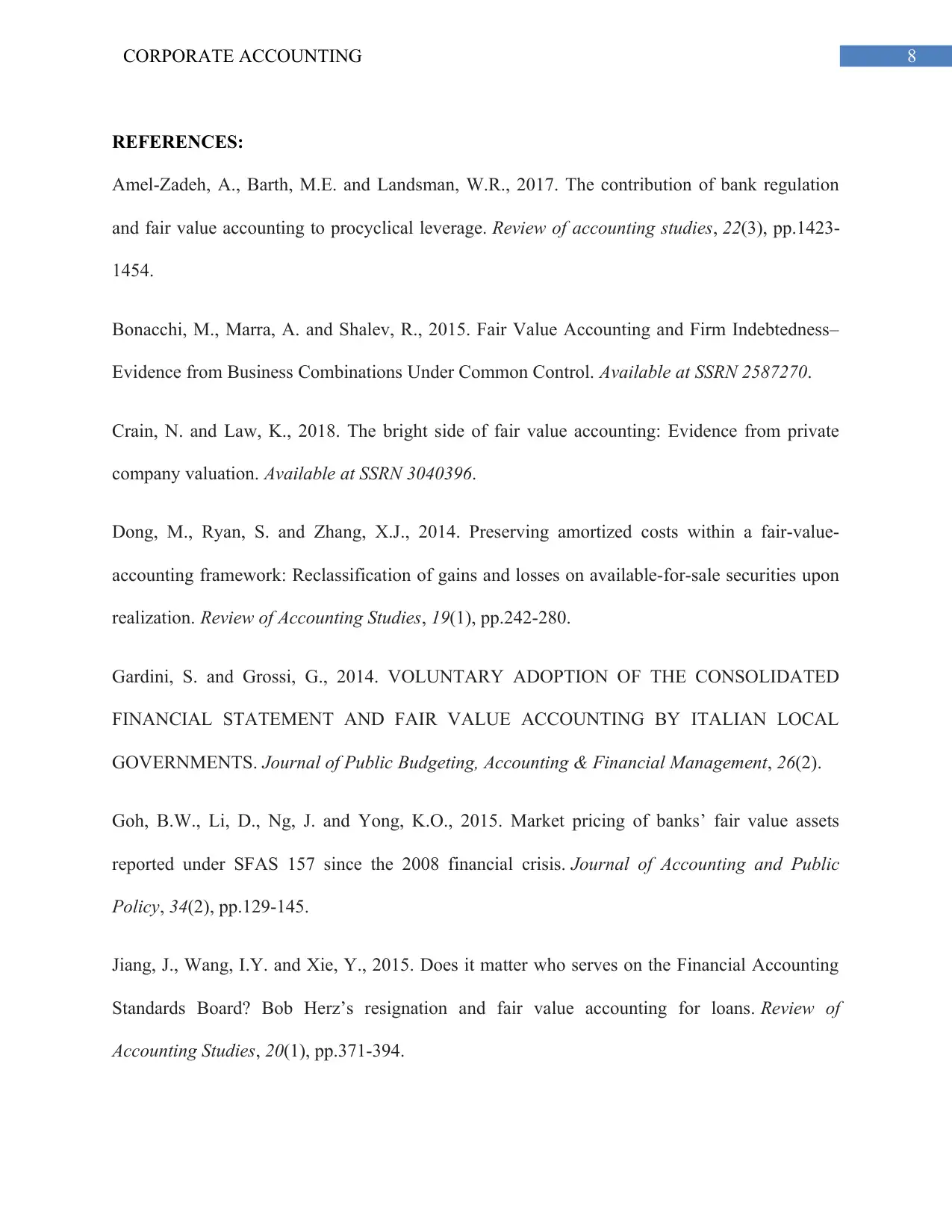
8CORPORATE ACCOUNTING
REFERENCES:
Amel-Zadeh, A., Barth, M.E. and Landsman, W.R., 2017. The contribution of bank regulation
and fair value accounting to procyclical leverage. Review of accounting studies, 22(3), pp.1423-
1454.
Bonacchi, M., Marra, A. and Shalev, R., 2015. Fair Value Accounting and Firm Indebtedness–
Evidence from Business Combinations Under Common Control. Available at SSRN 2587270.
Crain, N. and Law, K., 2018. The bright side of fair value accounting: Evidence from private
company valuation. Available at SSRN 3040396.
Dong, M., Ryan, S. and Zhang, X.J., 2014. Preserving amortized costs within a fair-value-
accounting framework: Reclassification of gains and losses on available-for-sale securities upon
realization. Review of Accounting Studies, 19(1), pp.242-280.
Gardini, S. and Grossi, G., 2014. VOLUNTARY ADOPTION OF THE CONSOLIDATED
FINANCIAL STATEMENT AND FAIR VALUE ACCOUNTING BY ITALIAN LOCAL
GOVERNMENTS. Journal of Public Budgeting, Accounting & Financial Management, 26(2).
Goh, B.W., Li, D., Ng, J. and Yong, K.O., 2015. Market pricing of banks’ fair value assets
reported under SFAS 157 since the 2008 financial crisis. Journal of Accounting and Public
Policy, 34(2), pp.129-145.
Jiang, J., Wang, I.Y. and Xie, Y., 2015. Does it matter who serves on the Financial Accounting
Standards Board? Bob Herz’s resignation and fair value accounting for loans. Review of
Accounting Studies, 20(1), pp.371-394.
REFERENCES:
Amel-Zadeh, A., Barth, M.E. and Landsman, W.R., 2017. The contribution of bank regulation
and fair value accounting to procyclical leverage. Review of accounting studies, 22(3), pp.1423-
1454.
Bonacchi, M., Marra, A. and Shalev, R., 2015. Fair Value Accounting and Firm Indebtedness–
Evidence from Business Combinations Under Common Control. Available at SSRN 2587270.
Crain, N. and Law, K., 2018. The bright side of fair value accounting: Evidence from private
company valuation. Available at SSRN 3040396.
Dong, M., Ryan, S. and Zhang, X.J., 2014. Preserving amortized costs within a fair-value-
accounting framework: Reclassification of gains and losses on available-for-sale securities upon
realization. Review of Accounting Studies, 19(1), pp.242-280.
Gardini, S. and Grossi, G., 2014. VOLUNTARY ADOPTION OF THE CONSOLIDATED
FINANCIAL STATEMENT AND FAIR VALUE ACCOUNTING BY ITALIAN LOCAL
GOVERNMENTS. Journal of Public Budgeting, Accounting & Financial Management, 26(2).
Goh, B.W., Li, D., Ng, J. and Yong, K.O., 2015. Market pricing of banks’ fair value assets
reported under SFAS 157 since the 2008 financial crisis. Journal of Accounting and Public
Policy, 34(2), pp.129-145.
Jiang, J., Wang, I.Y. and Xie, Y., 2015. Does it matter who serves on the Financial Accounting
Standards Board? Bob Herz’s resignation and fair value accounting for loans. Review of
Accounting Studies, 20(1), pp.371-394.
⊘ This is a preview!⊘
Do you want full access?
Subscribe today to unlock all pages.

Trusted by 1+ million students worldwide
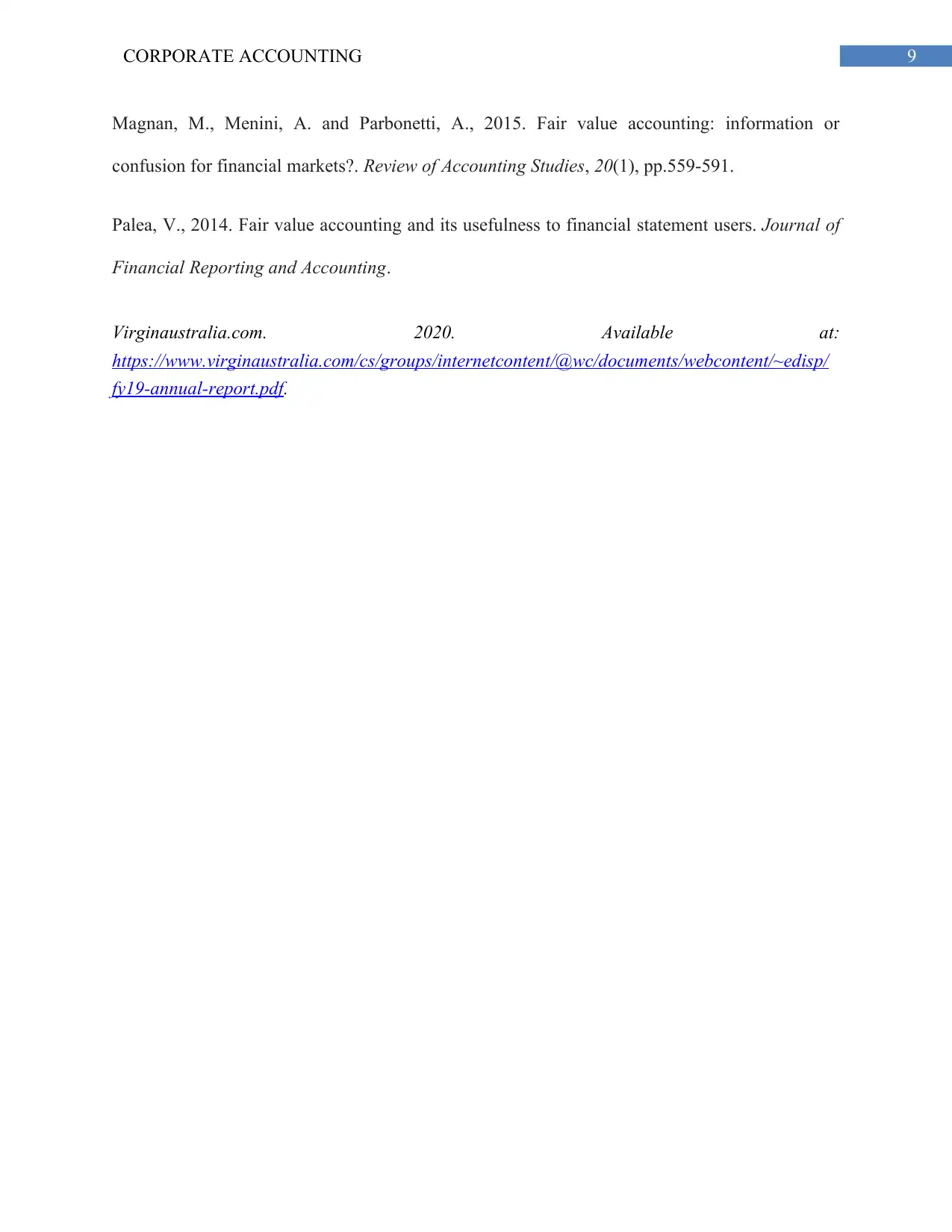
9CORPORATE ACCOUNTING
Magnan, M., Menini, A. and Parbonetti, A., 2015. Fair value accounting: information or
confusion for financial markets?. Review of Accounting Studies, 20(1), pp.559-591.
Palea, V., 2014. Fair value accounting and its usefulness to financial statement users. Journal of
Financial Reporting and Accounting.
Virginaustralia.com. 2020. Available at:
https://www.virginaustralia.com/cs/groups/internetcontent/@wc/documents/webcontent/~edisp/
fy19-annual-report.pdf.
Magnan, M., Menini, A. and Parbonetti, A., 2015. Fair value accounting: information or
confusion for financial markets?. Review of Accounting Studies, 20(1), pp.559-591.
Palea, V., 2014. Fair value accounting and its usefulness to financial statement users. Journal of
Financial Reporting and Accounting.
Virginaustralia.com. 2020. Available at:
https://www.virginaustralia.com/cs/groups/internetcontent/@wc/documents/webcontent/~edisp/
fy19-annual-report.pdf.
1 out of 10
Related Documents
Your All-in-One AI-Powered Toolkit for Academic Success.
+13062052269
info@desklib.com
Available 24*7 on WhatsApp / Email
![[object Object]](/_next/static/media/star-bottom.7253800d.svg)
Unlock your academic potential
Copyright © 2020–2025 A2Z Services. All Rights Reserved. Developed and managed by ZUCOL.





